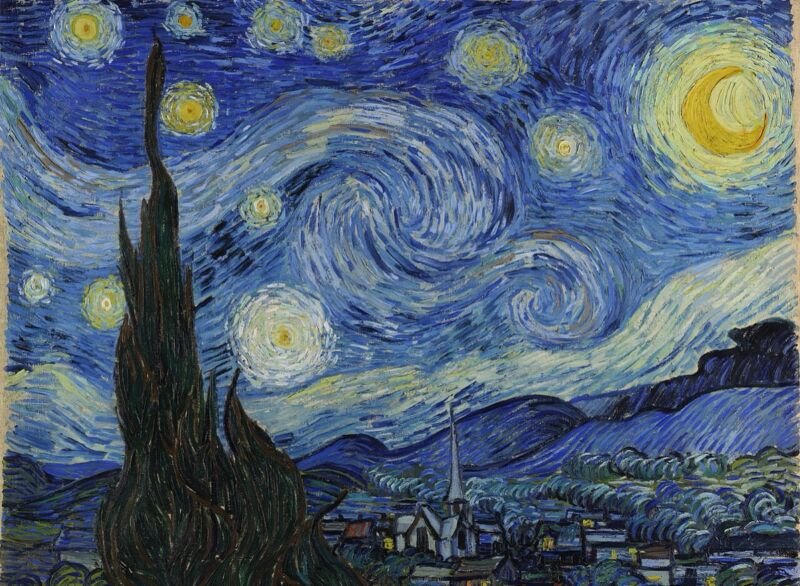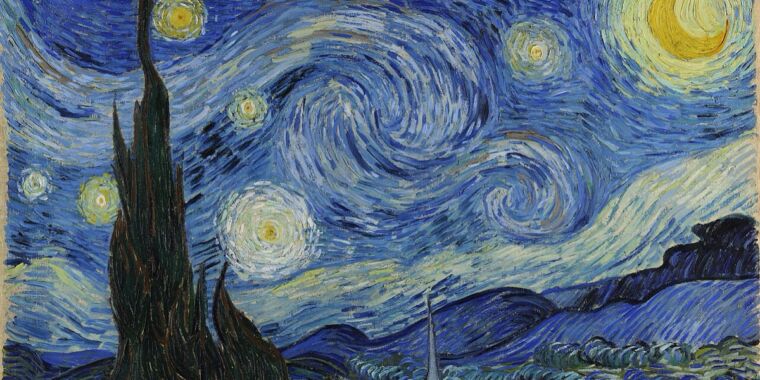
Public domain
Vincent van Gogh's most famous painting is The starry night (1889), created (along with several other masterpieces) during the artist's stay in a psychiatric institution in Arles following his breakdown in December 1888. Where some have seen the swirling eddies of the night sky depicted in Starry Night As a reflection of van Gogh’s own inner turmoil, physicists often see a masterful depiction of atmospheric turbulence. According to a new paper published in the journal Physics of Fluids, the illusion of motion in van Gogh’s blue sky also comes from the scale of the brushstrokes — a second kind of “hidden turbulence” on the microscale that spreads across the entire canvas.
“It reveals a deep and intuitive understanding of natural phenomena,” said co-author Yongxiang Huang of Xiamen University in China. “Van Gogh's precise depiction of turbulence may have come from studying the movement of clouds and the atmosphere or an innate sense of how to capture the dynamics of the air.”
As previously reported, in a 2014 TED-Ed talk, Natalya St. Clair, a research associate at the Concord Consortium and co-author of The art of mental arithmeticused Starry Night to shed light on the concept of turbulence in a flowing fluid. In particular, she talked about how Van Gogh’s technique allowed him (and other Impressionist painters) to depict the movement of light across water or in the twinkling of stars. We think of this as a kind of shimmering effect because the eye is more sensitive to changes in the intensity of light (a property called luminance) than to changes in color.
In physics, turbulence refers to strong, sudden movements in air or water, usually characterized by eddies and vortices. Physicists have struggled for centuries to describe turbulence mathematically. It remains one of the greatest challenges in the field. But a Russian physicist named Andrei Kolmogorov made significant progress in the 1940s when he predicted that there would be a mathematical relationship (now known as Kolmogorov scaling) between how the velocity of a flow fluctuates over time and the rate at which it loses energy as friction.
That is, some turbulent flows exhibit energy cascades, with large eddies transferring some of their energy to smaller eddies. The smaller eddies in turn transfer some of their energy to even smaller eddies, and so on, creating a self-similar pattern at many spatial scales. Experimental evidence since then has shown that Kolmogorov was not so far off the mark in his prediction.
In 2019, two Australian graduate students analyzed the painting mathematically and concluded that it has the same turbulent signature as molecular clouds (where stars are literally born), based on a 2004 Hubble image of turbulent swirls of dust clouds moving around a supergiant. They examined digital photographs of several Van Gogh paintings and measured the brightness variation between any two pixels, calculating the probability that two pixels at a given distance would have the same luminance. They found evidence of something remarkably close to the Kolmogorov scale, not only in Starry Nightbut also in two other paintings from the same period in Van Gogh's life: Cornfield with crows And Road with cypress and star (both painted in 1890).
Brushstrokes on a micro scale
Yinxiang Ma
Huang is a marine scientist who collaborated with physicists to take a closer look at the turbulent patterns in Van Gogh’s masterpiece. They focused on studying the spatial scales of the painting’s 14 primary swirling vortices, using the relative brightness of the paint colors as an analog for kinetic energy. Specifically, they precisely measured typical brushstroke sizes and then compared those scales to what is predicted by fluid dynamics.
Their findings confirmed the 2019 conclusion that the overall painting closely follows Kolmogorov’s law. The team also found that the microscale paint strokes follow another phenomenon known as Batchelor scaling, named after Australian mathematician George Batchelor, who specialized in fluid dynamics. It’s similar to Kolmogorov’s law, except that instead of describing the smallest scales of turbulence before viscosity becomes dominant in a system, Batchelor scaling describes the smallest length scales of fluctuations before diffusion becomes dominant. It’s quite rare to find both types of scaling in a single atmospheric system, the authors say.
This is further evidence that Van Gogh had an exceptionally refined intuitive sense of turbulence, and he captured it beautifully in Starry Night. There may also be implications for fluid dynamics. “Turbulence is considered to be one of the intrinsic properties of high Reynolds flows dominated by inertia, but recently turbulence-like phenomena have been reported for various types of flow systems at a wide range of spatial scales, with low Reynolds numbers where viscosity is more dominant,” Huang said. “It seems that it is time to propose a new definition of turbulence to encompass more situations.”
DOI: Physics of Fluids, 2024. 10.1063/5.0213627 (About DOIs).

